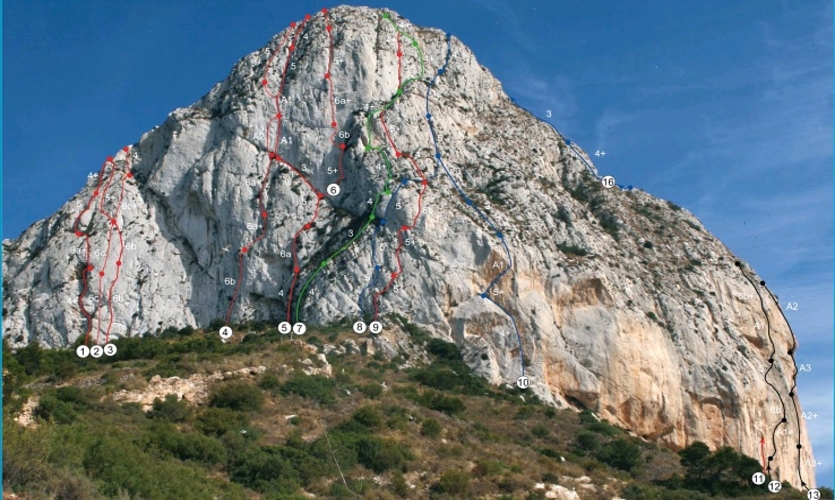*IT IS FORBIDDEN to climb during the nest period on the following months: april, may and june
Download the leaflet with all the climbing routes

LOCATION AND ACCESS
BASE
We can reach Calp by the N-332 or the AP-7, taking exit 64 Altea/Calp to continue on the N-332 towards Calp/Valencia. To get to the north face, we will leave the car in the car park that gives access to the interpretation center of the Parc Natural del Penyal d'Ifach.
POSITION 38°38’21”N - 0° 4’22”E
In case of going to the south or west slope, we must follow the indications to the port of Calp.
POSITION 38°38’16”N - 0° 4’19”E
APPROACH
From the north car park we will take the ascending track that leaves us at the interpretation center, to continue along the path that leads to the summit and that passes through the base of the wall. 15 minutes.
To access the routes on the south face and the west face, we must go all the way along Paseo Príncipe de Asturias, which runs along the sea, and then take the path that goes up at the foot of the wall. From 10 to 20 minutes depending on the route.
DESCEND
From the summit, through the north face, a beautiful and slippery path descends.
THE ENVIRONMENT
For the hiker, the summit of the rock is a must. We can access it through the beautiful path that runs along the north face, going through a curious tunnel of more than 50 meters. Another alternative is the ascent to the Sierra de Bernia from Pinos or from Altea la Vella, by the P.R.-C.V. 7, which offers magnificent views of the rock and the bay of Altea.
The beaches and coves of Calp will be a good choice for days that are too hot or for afternoons after a good climb.
Next to the rock, in its immediate vicinity or on the isthmus that connects it with the coast, the historic Calp has developed, with vestiges of prehistoric, Iberian, Phoenician or Roman cultures, as evidenced by the popularly called Baños de la Reina, which are, in Actually, an ancient Roman salting factory. At the foot of the rock are the ancient Roman salt pans, an important ecological area that is home to a large number of migratory birds.
In the fishing port are the facilities of the Club Náutico de Calp and the marinas of Puerto Blanco and Les Bassetes also stand out. You can practice scuba diving, windsurfing, water skiing, swimming and sailing in general. Another interesting activity is caving and sport climbing, which we can practice in the Oltà mountain range.
As for Calp cuisine, we cannot forget its various rice dishes such as arroz caldoso, arroz con bogavante or arròs de senyoret, based on grouper or sliced squid, prawns and fish stock. This name comes from the way in which the "gentlemen" eat rice: all peeled, without bones and without having to get your fingers dirty. We must highlight the fish-based dishes such as cruet de peix, which we can taste in the many restaurants near the port.


